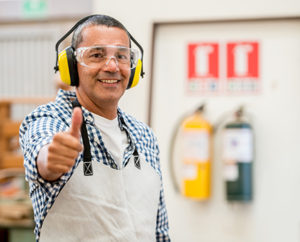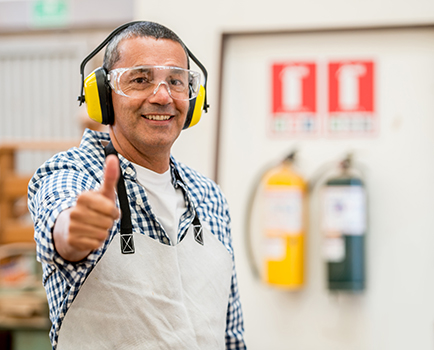By George Grayson, Southern New England Account Manager
 Quiz time! What is the name of the skilled trade in which the primary work performed is the measurement, cutting, framing and installation of building materials with the use of power tools and equipment? Carpentry it is. You know it because that’s what you do for a living. Now a harder question: What is it going to happen if you get hurt and you are unable to get a carpenter job for some time? The answer is simple. Do your best not to find out. Your carpentry safety depends upon the actions you take to deal with carpentry hazards on the jobsite. Below, we talk about some of these risks and what you need to do to stay out of danger.
Quiz time! What is the name of the skilled trade in which the primary work performed is the measurement, cutting, framing and installation of building materials with the use of power tools and equipment? Carpentry it is. You know it because that’s what you do for a living. Now a harder question: What is it going to happen if you get hurt and you are unable to get a carpenter job for some time? The answer is simple. Do your best not to find out. Your carpentry safety depends upon the actions you take to deal with carpentry hazards on the jobsite. Below, we talk about some of these risks and what you need to do to stay out of danger.
Maintain Housekeeping
Every carpenter job is a new challenge that requires precision and attention to detail as well as focus on safety. Having the carpenter skills it takes doesn’t mean ignoring carpentry safety. This is really important when you are responsible for other carpenters on the jobsite and when other tradespeople rely on you and your work for their safety. To best meet expectations, you need to be aware of and maintain proper housekeeping. For example, walk the site every day to ensure that the area of work is free from tripping hazards such as debris and protruding nails that can cause an accident. Remember that good housekeeping eliminates risks.
Use PPE
Another way to deal with carpentry hazards is to use the necessary personal protective equipment (PPE) for the carpenter job you do. For example, use respirators and masks to prevent inhalation of saw dust, adhesives and finishes and coatings that cause immediate and longer-term health effects. Similarly, wear protective glasses to prevent flying particles such as wood chips and dust from causing eye injuries. Make sure you use safety harnesses and you wear a hard hat every time you work at height. In other words, strengthen carpentry safety by using the proper PPE that helps you eliminate and reduce hazards.
Improve Ergonomics
 With every carpenter job you have to work in awkward positions such as bending, twisting, and stretching that causes fatigue, body aches and muscle pain. You often have to carry and lift heavy materials and equipment that puts extra stress on your back and you have to perform repetitive tasks that can cause repetitive strain injury. To deal with carpentry hazards like the ones above, you need to work on improving your ergonomics. Changing positions often, asking for help when you have to lift and taking regular breaks to prevent fatigue are just a few of the things you can do to make your work easier and less wearing.
With every carpenter job you have to work in awkward positions such as bending, twisting, and stretching that causes fatigue, body aches and muscle pain. You often have to carry and lift heavy materials and equipment that puts extra stress on your back and you have to perform repetitive tasks that can cause repetitive strain injury. To deal with carpentry hazards like the ones above, you need to work on improving your ergonomics. Changing positions often, asking for help when you have to lift and taking regular breaks to prevent fatigue are just a few of the things you can do to make your work easier and less wearing.
Don’t Ignore Weather Conditions
When you deal with carpentry hazards you need to keep in mind the weather conditions. Chances are that you are going to find yourself working in all types of weather. From being exposed to severe wind to working on a ladder on a 100°F day, carpentry safety must be your top priority. Be sure to wear the appropriate protective clothing that eliminates risk hypothermia or heat exhaustion. If it is too cold outside, be aware of slips and falls, wear waterproof shoes or boots with slip-resistant treads and take regular breaks in warm locations. If it is too hot, start work early in the day, drink water even if you are not thirsty and take frequent breaks in the shade. Don’t try to beat weather conditions; it’s a losing game.
Avoid Slack
Slack with carpentry safety means trouble. Likewise, cutting corners leads to accidents and tradespeople getting hurt. Before starting any carpenter job, make sure that you have the necessary tools and equipment and that these work properly. Are your carbide-tipped saw blades in a good shape? Are you using the right ladders for the job? Are there safety rails on the platforms you are going to work? Did you walk the jobsite to ensure that there are no exposed wires? The only way to deal with carpentry hazards is staying alert and responsible.
Key Takeaways to How to Deal with Carpentry Hazards and Risks:
- Maintain good housekeeping to eliminate hazards and risks
- Always use the necessary PPE for the carpenter job you perform
- Work on improving ergonomics during work
- Be prepared to work in different weather conditions
- Stay alert and on top of carpentry safety conditions on the jobsite
About TradeSource
Founded in 1993, TradeSource is a construction labor solutions firm focused on delivering labor solutions to contractors throughout the United States. By supplying skilled tradespeople – where and when they’re needed – we help contractors grow their companies, without the associated costs and hassles of full-time hires. Likewise, we match qualified employees with rewarding and well-paying job opportunities in the construction industry. www.tradesource.com

